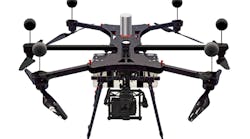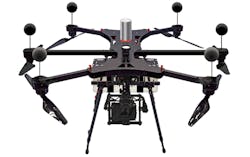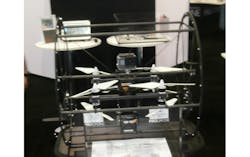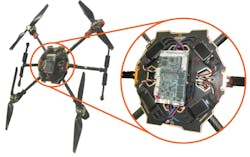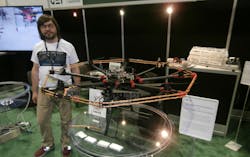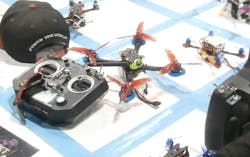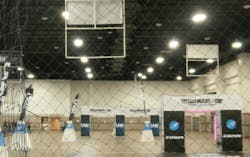All forms of drone technology, from Intel’s enterprise-oriented Insight Platform to anti-drone guns, greeted attendees of the recent AUVSI Xponential show. The Insight Platform digital asset management system can combine and manage data from multiple drones and drone flights
Another highlight from the show was PrecisionHawks’ Beyond Visual Line of Site (BVLOS) drone (Fig. 1). Most commercial drones must be flown following line-of-sight (LOS) rules.
1. PrecisionHawk’s Beyond Visual Line of Site (BVLOS) drone platform includes the acoustic-based aircraft detection system (SARA PANCAS).
The drone incorporates SARA’s Passive Acoustic Non-cooperative Collision-Alert System (PANCAS). It uses an array of lightweight acoustic probes and a custom-designed digital-signal processor to detect other drones. With the ability to subtract its own sounds, the drone can track other sounds.
The PrecisionHawk platform includes an obstacle avoidance system as well as supporting high-end sensors. The hybrid engine provides over two hours of flight time. Furthermore, the drone runs PrecisionHawk’s proprietary low altitude traffic and airspace safety platform (LATAS).
2. Prodrone was showing off a prototype drone surrounded by a moving cylinder.
Prodrone had its suite of drones on display in addition to some new prototypes. One was a quadrotor inside a moving cylinder (Fig. 2). Unlike some drones that use different sensors to try to avoid obstacles, this quadrotor is designed to bump into them. In particular, the system is designed for wall inspection, where the drone flies up to a wall and stays in contact courtesy of the cylinder. The drone’s camera is then at a fixed point away from the wall and the drone can easily move up and down. It’s simple and accurate.
A number of other drones use a similar technique to protect the drone. These use a sphere allowing a drone to bump into an obstacle without a major collision. In both cases, the sphere or cylinder is made from lightweight materials.
3. WinSystems exhibited small single-board computers like the ITX-F-3825 that could easily control a drone.
Several embedded board and system vendors attended the show, including Versalogic, Extreme Engineering Solutions (X-ES), and WinSystems. WinSystems was highlighting its small-form-factor, ITX-F-3825 single board computer (SBC) with a dual-core, 1.33-GHz Atom E3825 (Fig. 3). It has 2 GB of soldered DDR3L RAM plus a full size Mini-PCIe slot with mSATA support and an M.2 B Key slot. A significant chunk of the board is dedicated to all of the peripheral connectors. The SBC can be used for non-UAV applications, too, such as digital signage, robotics, or in medical applications.
A good portion of the drones on display at the show use electric motors. This makes it easy to control copters with multiple propellers. Of course, battery technology then becomes the limiting factor of flight time. Tethered drones, of which there were a number, pipe power up a cable. However, Global Energy Transmission (GET) was showing off its wireless-power-distribution technology, which offers another way to deliver power to an aircraft or other embedded system (Fig. 4).
4. Global Energy Transmission demonstrated its wireless-power-distribution technology with a custom drone.
GET’s Distant Wireless Power Technology can operate over distances on the order of 20 to 30 meters delivering kilowatts of power. A cell-tower-style wireless-power network could support drones throughout a city providing delivery services, monitoring, and security applications. It’s 80% for a single device and over 85% efficient for multiple devices.
Of course, not everyone likes drones or at least ones that may be flying nearby. Remote-controlled drones normally use wireless radios like Wi-Fi to communicate between the drone and the ground station. IXI Technology's Drone Killer is designed to disrupt this communication (Fig. 5).
5. IXI Technology’s Drone Killer is designed to disable drones by interrupting communication.
Drone Killer has an effective range of 400 m and disrupts command and control (C2) wireless communication using FCC-compliant data-communications interruption techniques. This includes GPS. It’s designed for use near high-asset facilities. Unfortunately, it may be less effective against autonomous systems that use an inertial measurement unit (IMU) instead, or in addition to GPS.
Currently, the majority of drones are remote-control devices that use GPS, and these would be susceptible to the Drone Killer. At this point, though, the device “has not been certified by the U.S. FCC or NTIA for use by other than the U.S. Military and Government and Federal Agency personnel.”
6. International Drone Racing Association’s (IDRA) competing pilots sit side-by-side while their drones race through a nearby course.
Xponential was host to International Drone Racing Association (IDRA). Drone pilots wear virtual-reality (VR) googles to view what their racing drone sees (Fig. 6). IRDA hosts races at multiple locations around the world. The competition is fast-paced and we were entertained by some fancy piloting at very high speeds.
The drones include a camera; the video feed is sent to the pilot’s VR system. A simple joystick controller allows the pilots to remain almost immobile while making their drones zip through the course (Fig. 7).
7. IRDA uses a variety of VR-enabled drones.
Part of the drone competition course (Fig. 8) is shown here. There were drones flying, but they are very small compared to the size of the course. The drones are lit with LEDs to make them easier to see, but don’t photograph well because due to their small size and speeds at which they’re traveling. It’s easier to capture on video or to watch in person. Races could be done alone for time or up to four drones would race at a time. They would all start on a pedestal, and each would have to fly the same course. The difference between an expert and a novice was apparent by the flawlessness of the experts and the crash—but no burn—tendencies of the novices.
8. Drone racing typically includes flying through gates that are placed high and low. Though it may look easy, it’s not as highlighted by the number of crashes that occur.
Of course, even experienced pilots crashed when trying to push the cornering. Still, the only damage would be to a small, noisy quadcopter. Races don’t last long, as the piloting and competition are intense—a single battery swap is often all that’s needed between runs.
